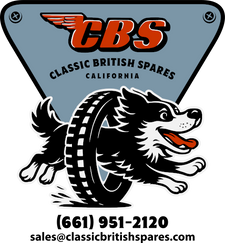
Selecting The Correct Hone Grit
Choosing the correct hone grit for your vintage British motorcycle is a touchy subject. It's like debating whether or not you should install your piston rings dry or with oil upon assembly.
No matter who you ask there will always be some type of backlash of which hone grit you should use when honing a cylinder - some will agree with you and most won't.
Today's blog post we will dive into a topic that happens to about what type of hone grit you should use before installing new piston rings in your vintage British motorcycle.
You can use all the info discussed below on most vintage British motorcycles including Triumph, BSA, Norton and other marks.
Let's get started...
Cylinder barrel liner & piston rings
Understanding what the cylinder barrel liner and piston rings are composed from will give you an identification of what type of grit should be used.
Most cylinder barrel liners that where fitted on vintage British motorcycles where made from cast iron.
Cast iron happens to be the same material in which the most cylinder barrels where formed from.
Rings originally where made from a grey cast iron material but today many manufactures are making rings using different materials such as ductile and chrome.
Grey cast iron rings are typically the most popular replacement rings in our industry as grey cast iron is more "forgiving" and affordable. Great for bores that are not perfectly round or true compared to today's standards where everything is far more precise and the tolerances are tighter.
Most ring manufactures today including Grant, Hastings, and Goyete typically will supply grey cast iron rings as replacements - although some ring manufactures will supply chrome rings.
Nitty-gritty
According to a Triumph service bulletin dated September 20, 1971 - Triumph recommends that you use a 150 grit hone to hone your cylinders upon installation of new piston rings.
So why 150 grit? Isn't that too course?
According to today's standards a modern motorcycle mechanic or automobile mechanic would think 150 grit is too course for most applications but they simply don't understand our reality.
The reality today is Nikasil plated cylinders will allow to run much tighter clearances than standard cast liners, but Nikasil plated cylinders require a different type of hone and grit. Just these two different materials required different steps and standards to get them set up properly and should not be interchanged.
150-220 grit in our would is ideal when using cast iron rings.
The key to a successful break in is that you must lap or "seat" the piston rings to get the maximum performance out of an engine.
Now I understand that there is more than just using the correct grit to having a successful top end job. Installation, oil type, and preparation are all other variables that will give you different results.
Incorrect finish - symptoms
Choosing the incorrect hone grit whether to course or too fine can cause multiple problems that lead to poor engine performance or failure.
Using to fine of a grit will not allow you to properly lap the rings in and using to coarse of a grit will wear your rings quickly.
Many racers today use a course grit to hone there barrels. Using a courser grit will allow the rings to "lap in" quicker but will also allow the rings to wear out quicker.
Below we will cover some quick points that are typical of poor ring seating and hone selection.
| Too course | Too fine |
|
|
He said - she said
If you read online forums, talk to your local engine builder, or read a magazine about engine building you will find that everyone has different opinions and answers of which grit hone to use.
In this case (just like many) I think everyone is right to a certain point. Everyone has there own way of doing this.
However, I do not personally feel that using anything higher than a 220 grit for our applications would give you successful results. I have always used an 180 grit hone with great results using both Hastings rings and Grant cast rings.
What type of hone do I need?

Using a bottle brush hone is efficient for most applications and engine builders.
Bottle brushes are also affordable and easily obtinable.
There are more precise tools on the market such as The Lyle 15,000 model which features an adjustable "elbow" which allows you to properly hone your cylinder barrel Keeping it Concentric - my personal favorite.
Flex-Hone makes an abrasive composed of Silicone-Carbide which is great for cast iron liners.
Flex-Hone happens to manufacture hones with a grit rating from 20 all the way to 800. Of course the higher number the finer the stone and finish. Click here for more information on Flex-Hone products.
Preparation is key
Remember preparation is the key to a successful top end and job.
Cutting corners is not an option. I always recommend that you buy the highest quality tools to get the job done.
I understand that every builder has their specific budget but if you can't afford quality tools just always understand that the job may not come out as good as it should've been if you had the correct tools.
If you have any questions please feel free to let's us know by commenting below. Share this blog with a mate on Facebook, or on Pintrest.
Thanks for reading!

